Castleford FootbridgeWinner of a CEEQUAL Outstanding Achievement Award 2011 for Community & Stakeholders |

|
Design & Build Award
Project Team:
Design: Tony
Gee & Partners
Construction: Costain
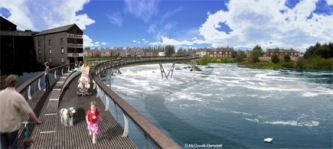 |
|
The Project
The Castleford Footbridge, a £4.8million landmark structure, is the final and most ambitious of 11 schemes that form The Castleford Project, a groundbreaking urban renewal scheme that aims to spark regeneration and a new confidence in this former coal-mining town.
The project was founded by Channel 4 Television (C4), local community and civic groups and Wakefield Metropolitan District Council. From an initial contribution of £100,000 by C4, the project is now valued at over £12million and is widely credited with levering an additional £200million of investment into the town. C4 filmed the project for a major series broadcast in August 2008 – the world’s first televised regeneration scheme.
The Footbridge project was an NEC fixed-price, Design & Build form of contract awarded in December 2006. With a concept design already in place, the client’s aspirations for the footbridge were established early in the tender process. Staying as true as possible to the architect’s vision, the contractor sought to deliver innovation in construction techniques.
Environmental Issues
The S-shaped footbridge, four metres wide and spanning more than 130 metres across the River Aire features innovative engineering solutions adopted during its design and construction. The construction of the river piers was one of the most high-risk activities of the project. The three piers had to be constructed within eight metres of an existing, fast-flowing weir and in river depths that varied from just half a metre to seven metres.
There was always a risk that construction activities could affect the watercourse and cause pollution. Early consultation with the Environment Agency allowed concerns regarding pollution potential, risk of flooding and ecological protection to be fully understood and, by working closely with the Environment Agency, the contractor was able to obtain the necessary consents prior to starting construction, which was invaluable in terms of the programme. This early involvement meant the environmental plans identified and considered site-specific environmental aspects, the concerns of the Environment Agency and detailed control measures to mitigate these risks.
Following detailed research, Costain decided to construct single 1800-diameter bored piles for each pier. These incorporated high-tensile Macalloy bars, which were used to secure pre-cast concrete pile caps and V-shaped steel bridge legs in place. All work was carried out from a modular jack-up barge, usually associated with marine works.
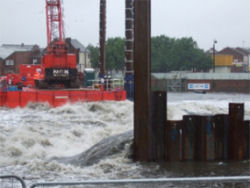 |
|
This method was chosen to reduce risks to the existing ecosystem and to reduce working time within a volatile river, which saw levels rise over 3.5 metres during the 2007 floods. The flexible working methods meant work could re-commence as soon as river levels fell, with no major remedial or clean-up work required.
In addition to the footbridge, a scheme to construct a fish pass to allow fish to ascend the rise of the weir was also completed. It consists of a lower slope, central resting pool and upper slope set into the existing weir structure. The fish pass was constructed for the Environment Agency as part of their ongoing efforts to provide migratory fish with unrestricted access to spawning grounds and will also benefit the rural economy. The footbridge provides an excellent vantage point from which to view the migratory fish using the fish pass.
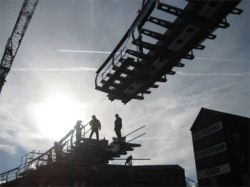 |
|
Innovation
The finishing works to the bridge involved complex and highly detailed architectural work. This included fitting distinct curved hardwood decking and handrailing. The hardwood, Cumaru, was imported from Brazil, via Holland. Full Forest Stewardship Council (FSC) certification guaranteed chain of custody from manufacture through to end use and provided assurance that the timber came from a sustainable source.
The timber was fabricated and installed to a high standard of craftsmanship to produce a high-quality finish, while the handrail was designed to conceal an energy-efficient LED lighting system that lights the deck, but does not adversely impact on neighbouring properties.
The majority of timber and steel fabrication took
place off-site to reduce the impact on the environment
and the local community.
Further innovation included simplifying the bridge fabrication
to twin-box beams from a multi-cell box girder. To reduce
the apparent depth of the structure, one box on each
curve of the ‘S’ gradually increases in
height, rising out of the structure. This creates synergy
between the structural depth and provides seating for
a unique public space in the middle of the river.
Finishing also included a high level of stainless steel fitting, including a highly decorative, bespoke cladding to the benches and parapet posts that complement the decking.
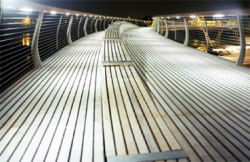 |
|
Community involvement
From the outset, community engagement with the footbridge project was key. Local community champions were closely involved throughout the design and construction stages, commenting on sample materials, visiting off-site fabricators and site, to ensure the bridge met their objectives. The result is universal acclaim of the completed bridge by the local community and visitors.
The contractor employed a community liaison manager to work with the local community throughout construction. A measure of the success of the team’s close relationship with the local community came with a Considerate Constructor’s Silver Award for the Footbridge project.
Before work commenced, the contractor hosted a pre-construction event for local people to address any concerns. A 24-hour helpline was set up to respond to enquiries or complaints and an ‘open door’ policy operated on site for members of the public. A visitor centre and display area was created within the site compound as well as information boards and viewing areas on either side of the river.
isplays in the local library and regular newsletters kept those living near the works up to date.
Following numerous visits to schools to deliver site safety talks, hundreds of children visited the site to see work in progress.
Local children created clay animals and insects for the visitor centre, reflecting the diversity of wildlife found in the river and on the banks. Bridge design and construction lessons complementing the school curriculum were delivered in local secondary schools.
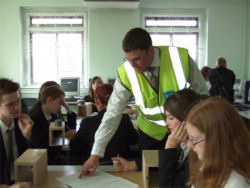 |
|
To raise the profile of the scheme among a wider audience, the contractor worked proactively with local and regional media, issuing regular press releases, providing access for photographs and, on two occasions, offering the site as a broadcast location for Yorkshire. BBC Radio Leeds performed a live broadcast from the site, interviewing local businesses, members of the public and the site team as part of their Breakfast Show.
Resident association meetings were attended regularly by contractor representatives and monthly communication reports were produced to update local councillors, project managers and the town centre partnership board that formed the footbridge project steering group.
In recognition the scheme was shortlisted for the British Construction Industry’s (BCI) Prime Minister’s Better Public Building Award for 2008.
Sustainability
The bridge has a projected lifespan of 120 years. All structural steelwork is protected against corrosion with a highway-specification paint system with an additional galvanized coating for the legs, which are immersed in water. As such, no maintenance should be necessary for up to 12 years and only minor maintenance is required up to 20 years. The footbridge is constructed to accommodate wheel loads from under-deck inspection vehicles and scaffold loads in combination with pedestrian load, ensuring any under-deck maintenance can be carried out without the need to close the bridge to the public.
The Grand Opening
Castleford Footbridge was officially opened to the
public on 4 July 2008. Before completion of the new
footbridge the only means of crossing the river was
one existing bridge, built in 1808. With narrow footpaths
and thundering lorries and buses, the bridge was becoming
increasingly dangerous for pedestrians to use.
The new footbridge completely separates pedestrians
from traffic and is helping to connect the community
back to a river that is an intrinsic part of its history.
The footbridge is not simply a means of crossing the
river, it also provides a place to wander, to meet and
to sit and enjoy the river and its wildlife. The community’s
aspirations are for the footbridge to become a destination
in its own right, attracting visitors to the river and
the town.
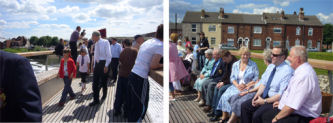 |
|
